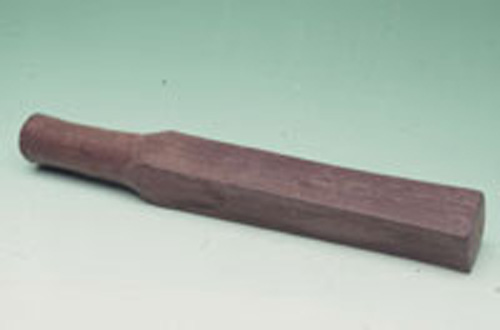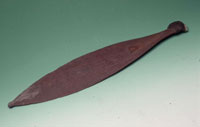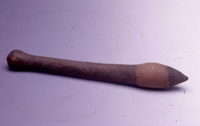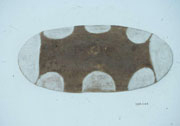
Click here to view image
Ike
wood
Mazzuolo for kahu, vegetable cloth made by women. The engravings and the reliefs on the surfaces of the mallets vary according to the different phases of the manufacture.
Isole Marchesi

Click here to view image
Ike
wood
Mazzuolo for kahu, vegetable cloth made by women. The engravings and the reliefs on the surfaces of the mallets vary according to the different phases of the manufacture.
Isole Marchesi


Click here to view image
E. A. D'Albertis 1932
documentazione
Ke’a tuki popoi / 2
C.D.A.1037
Hawaii
Anticamente la pietra veniva lavorata a percussione e levigata su rocce o con sabbia.
Usato per la preparazione dell'impasto del "popoi", cibo quotidiano costituito dal "mei", il frutto dell’albero del pane (Artocarpus altilis). Dopo la cottura il "mei", frutto dell'albero del pane (Artocarpus altilis), veniva pelato e grattugiato con schegge di conchiglia o di pietra. Gli uomini, seduti per terra all'estremità di un'asse di legno lievemente concava che avevano precedentemente inumidito con acqua, schiacciavano il "mei" con colpi brevi e veloci del pestello. Successivamente l'impasto veniva mescolato ad acqua o latte di cocco. Vita quotidiana
Pestle used in the preparation of popoi, daily food consisting of the fruit, mei, the bread tree (Artocarpus altilis) mixed with water or coconut milk.
Isole Marchesi


Click here to view image
To'i - axe
Wood, stone, vegetable fibres
The quality of the materials and the manufacture indicate that it was used in sacred works, for example in the construction of war canoes. The functionality of this type of tool was such that the Tahitians, in the eighteenth century, bought European axes to replace the stone blades with those of iron while maintaining the traditional body.
Tahiti, Society Islands


Click here to view image
Male costume for dance
Dyed vegetable fibres of Hibiscus tiliaceus (purau)
Per confezionare i costumi maschili e femminili da danza si utilizzano, dopo averle tinte, le fibre lunghe, morbide e resistenti ottenute dalla parte interna della corteccia (more) del purau, uno degli alberi più diffusi in gran parte della Polinesia orientale.
Tahiti, Isole della Società

Click here to view image
Boomerang (return trajectory)
wood
The return-trajectory boomerang - the only authentic boomerang in the proper sense - must be manufactured in a uniform manner, including a curvature in the center of about 135,- blunt or slightly salient on the convex side. It’s used as a hobby.
Launched with dexterity, it begins to rotate swiftly on itself rising in the air in the vertical plane of launch, then tilts laterally until it gradually reaches the horizontal position. It can describe a series of circles up to the descending trajectory that deposits it near the pitcher. The range, up to about 100 m, is shorter than that of the boomerang of no return, because part of the propulsion force is used for the return trajectory.
Murray River Region, Southeast Australia
Click here to view image
Boomerang
wood
It is not uniformly present across the Australian continent, and according to the various tribal areas or groups the forms and materials vary, as do the names that define it. Boomerang has been assumed in ethnography as a standard term.
It can perform multiple functions including a ritual role in ceremonies or be used as a percussion instrument.
Murray River Region, Southeast Australia

Click here to view image
D'Albertis Enrico Alberto 1932
inventario museale
Woomera
C.D.A.1225
Australia
L'arma veniva intagliata una semplice tavoletta di legno sulla cui estremità, terminante con un uncino o una scanalatura, si appoggiava l'arma da scagliare.
Accessorio per armi da getto Vi si appoggia l'arma da scagliare e fornisce all'arma stessa una potenza supplementare che moltiplica la forza, la gittata e la precisione. Guerra/caccia
In addition to throwing spears can have other functions: knife, container, etc. ; fitted at one end with a splinter of stone, flint or other material attached to resin wood, is used to light
the fire by rubbing.
Western Australia


Click here to view image
Bat
wood
It is used in hunting and fishing or to finish the animals wounded by the boomerang.
South-eastern Australia


Click here to view image
Shield
Wood, natural pigments
In addition to being a defensive weapon to counter the blows of boomerang or spear, it can also perform ritual functions.
Queensland


Click here to view image
Enrico A. d'Albertis 1912
provenienza
Wunda
C.D.A. 383
Unità di misura: cm
Tipo di misura: altezza
Valore: 75.5
Australia
Lo scudo, tipico di quest'area, veniva intagliato da un legno dolce leggero ed era decorato con motivi lineari incisi, enfatizzati dall'applicazione di ocra e pigmenti.
Difensiva Guerra
Shield made of a medium density wood; its name comes from the term wurnda which in the Bailgu language refers to the type of wood with which it is made. Originating in the Murchison River region
in western Australia, its diffusion also in other regions indicates the importance of this artifact in the trade between aboriginal groups.
It has three sections of grooves painted in red ochre and white clay. The design, called pandal, has vertical engraved lines at the top and bottom, horizontal or oblique lines in the middle section.
Region between Gascoyne River and Murchison River, Western Australia




Headquarters:
Municipality of Genoa - Palazzo Tursi
Via Garibaldi 9 - 16124 Genoa
C.F / VAT 00856920102